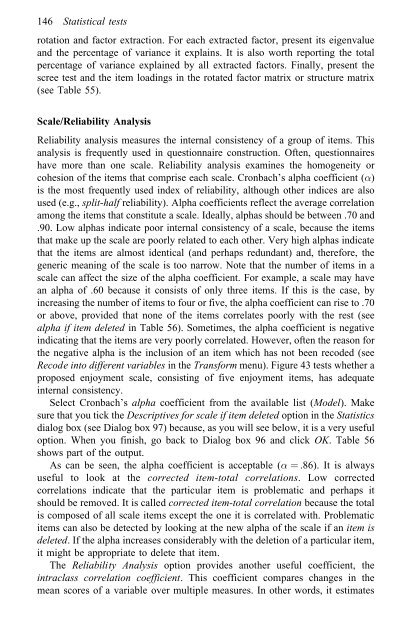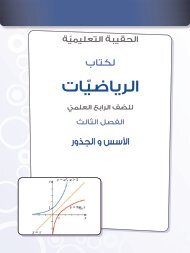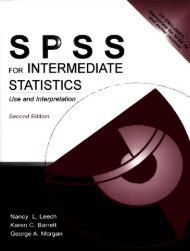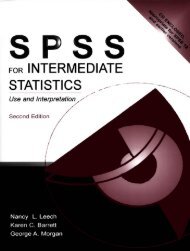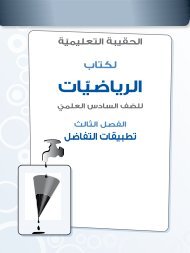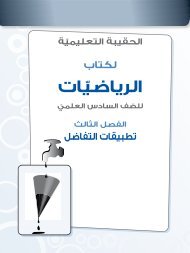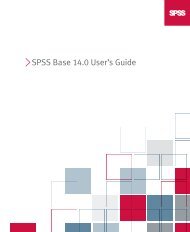A Step by Step Guide for SPSS and Exercise Studies
A Step by Step Guide for SPSS and Exercise Studies
A Step by Step Guide for SPSS and Exercise Studies
You also want an ePaper? Increase the reach of your titles
YUMPU automatically turns print PDFs into web optimized ePapers that Google loves.
146 Statistical tests<br />
rotation <strong>and</strong> factor extraction. For each extracted factor, present its eigenvalue<br />
<strong>and</strong> the percentage of variance it explains. It is also worth reporting the total<br />
percentage of variance explained <strong>by</strong> all extracted factors. Finally, present the<br />
scree test <strong>and</strong> the item loadings in the rotated factor matrix or structure matrix<br />
(see Table 55).<br />
Scale/Reliability Analysis<br />
Reliability analysis measures the internal consistency of a group of items. This<br />
analysis is frequently used in questionnaire construction. Often, questionnaires<br />
have more than one scale. Reliability analysis examines the homogeneity or<br />
cohesion of the items that comprise each scale. Cronbach’s alpha coefficient ()<br />
is the most frequently used index of reliability, although other indices are also<br />
used (e.g., split-half reliability). Alpha coefficients reflect the average correlation<br />
among the items that constitute a scale. Ideally, alphas should be between .70 <strong>and</strong><br />
.90. Low alphas indicate poor internal consistency of a scale, because the items<br />
that make up the scale are poorly related to each other. Very high alphas indicate<br />
that the items are almost identical (<strong>and</strong> perhaps redundant) <strong>and</strong>, there<strong>for</strong>e, the<br />
generic meaning of the scale is too narrow. Note that the number of items in a<br />
scale can affect the size of the alpha coefficient. For example, a scale may have<br />
an alpha of .60 because it consists of only three items. If this is the case, <strong>by</strong><br />
increasing the number of items to four or five, the alpha coefficient can rise to .70<br />
or above, provided that none of the items correlates poorly with the rest (see<br />
alpha if item deleted in Table 56). Sometimes, the alpha coefficient is negative<br />
indicating that the items are very poorly correlated. However, often the reason <strong>for</strong><br />
the negative alpha is the inclusion of an item which has not been recoded (see<br />
Recode into different variables in the Trans<strong>for</strong>m menu). Figure 43 tests whether a<br />
proposed enjoyment scale, consisting of five enjoyment items, has adequate<br />
internal consistency.<br />
Select Cronbach’s alpha coefficient from the available list (Model). Make<br />
sure that you tick the Descriptives <strong>for</strong> scale if item deleted option in the Statistics<br />
dialog box (see Dialog box 97) because, as you will see below, it is a very useful<br />
option. When you finish, go back to Dialog box 96 <strong>and</strong> click OK. Table 56<br />
shows part of the output.<br />
As can be seen, the alpha coefficient is acceptable ( ˆ .86). It is always<br />
useful to look at the corrected item-total correlations. Low corrected<br />
correlations indicate that the particular item is problematic <strong>and</strong> perhaps it<br />
should be removed. It is called corrected item-total correlation because the total<br />
is composed of all scale items except the one it is correlated with. Problematic<br />
items can also be detected <strong>by</strong> looking at the new alpha of the scale if an item is<br />
deleted. If the alpha increases considerably with the deletion of a particular item,<br />
it might be appropriate to delete that item.<br />
The Reliability Analysis option provides another useful coefficient, the<br />
intraclass correlation coefficient. This coefficient compares changes in the<br />
mean scores of a variable over multiple measures. In other words, it estimates


